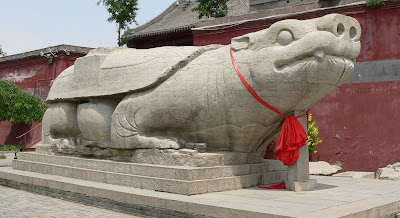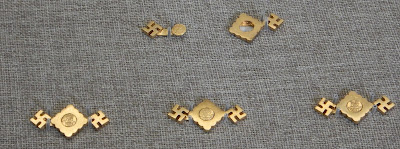The problem with philosophy in mathematics is that it is no longer part of the high school curriculum (at least not here in Ontario). It used to be, but in the last reorganization of the curriculum, it was sadly removed.
Most of us don't get to study this in university either. Most science majors are directed into some form of applied math (frequently calculus, the Bane of Geologists*; otherwise statistics). Consequently, most don't think about the differences between scientific reasoning and that of the mathematical kind. I know I never used to.
Scientific reasoning is inductive; meaning that whatever truths there are in the Universe have to be inferred from observations. You never know if your perception of the truth is accurate, however, all you can say about it is that it appears to be consistent with observations.
Mathematical reasoning is different because mathematics is a human construct. A system of mathematics is composed of a few true statements and a set of rules (rules of inference) for transforming those few true statements (axioms) into other true statements (theorems). The rules are chosen carefully so that the statements which sprout from them are true, provided they were seeded with truths.
But we get to decide what rules to apply. We don't always have to agree; but like playing a game, if we change the rules, we change the game. That doesn't mean that other games are less enjoyable than the one we normally play.
For Euclidean geometry, one of the axioms states that given a line and a point not on the line, there is only one line parallel to the first which passes through the point. However, if you want to play a game where there are no parallel lines, then you are pursuing
elliptic geometry. Or if you prefer to have more than one parallel line, in which case you are pursuing
hyperbolic geometry. Arguing about which one is true is meaningless.
What defines a great mathematical system? Well, first of all, it should be consistent--meaning that as long as you apply the rules of inference to a true statement, only true statements result. In other words,
all provable statements are true.
Secondly, we would like the system to be complete, meaning that it is possible to prove all true statements. In other words,
all true statements are provable.
Both of these criteria have different meanings, despite their similarity. A major goal for mathematicians has been to develop a system which is both consistent and complete, and in their
Principia Mathematica,
Whitehead and
Russell believed they had accomplished this.
Consistency is easy--the key is that the rules of inference tend to be simple (
e.g., if a = b, then a + c = b + c). But completeness is really difficult. Can we know every true statement? Can we know they are all true?
Consider Fermat's last theorem. First proposed (as far as we know) in 1637, it was not successfully proven until 1994. So for over 350 years, the truth of this theorem was unknown (it was then called Fermat's Conjecture). Once it was proven, we knew it was true. Prior to its proof, it was also a true statement, but we didn't know it was true. There may be other true statements out there that remain unproven. There are probably other conjectures which may be false, but our inability to prove them is not enough, by itself, to know that they are false.
So completeness is a very difficult hurdle to cross.
Spoiler alert--this discussion was rendered moot by Godel, who in 1931 showed that all non-trivial mathematical systems are either incomplete or inconsistent. We normally insist on consistency--the price is completeness. There are always unprovable truths.
Which brings us to Tron: Legacy (2010). There may be some spoilers ahead.
In this film, we have the character Flynn, who is the Creator of a virtual universe, his creation (Clu), his son (Sam), and his apprentice (Quorra). It's an old story--the one about the creation turning on his creator. Flynn has been seeking to create a 'perfect universe'; unfortunately, what is meant by perfect is not adequately described. Flynn does reference freedom and openness a lot.
The essential conflict in the story is between Flynn and his creation. Through flashbacks, we learn that as Flynn is building the virtual world, something unexpected happens. A new group of programs, isomorphic algorithms ('Isos') appears. When asked how they appeared, Flynn says, "They manifested . . . the conditions were right and they just appeared."
We might say that the Isos were emergent properties of the system. But here Flynn and Clu disagree about the meaning of their appearance. Both regard these as unexpected phenomena in their 'perfect' system. But Flynn looked at them in a positive manner, unexpectedly emerging from a system he imagined he'd controlled. From the lyrical way he describes them, we can see that he believed they represent a key to life and creation--manifestations of a blinding truth, which was inexplicable within the rules of the system. The beauty of this unexpected creation brings Flynn to the realization that there are states better than perfection.
Clu, by contrast, only sees the Isos as inconsistencies. Unfortunately, there is no positive spin you can put on an inconsistency in a system. It means a complete tear-down is necessary. And of course, the inconsistencies have to go.
Even worse, Clu sees that his Creator had become corrupted by these inconsistencies, having declared his intentions to protect them. So not only must the Isos be destroyed, but Flynn has to go too.
Flynn and his buddy Tron, moments before Clu stages his coup
Clu: "Do you still want me to create the perfect system?"
Flynn: "Yeah . . ."
And the coup begins. Flynn escapes into exile within the digital world, while Clu destroys the Isos and remakes the world into his image of perfection.
Flynn struggles to regain control of the world, but it turns out the more he fights, the stronger Clu becomes. He realizes his only hope is to do nothing. Clu is thus free to remake the world, but is unable to find Flynn, who therefore remains a potential threat, somewhere at the edge of the world. A kind of stalemate ensues, which Clu tries to break by introducing another piece to the board--luring Sam into the virtual world.
This is where the movie starts--we see Sam's attempts to understand the new world in which he has unexpectedly arrived. Facing death by gladiatorial combat, Sam is rescued by Quorra, and reunited with his father.
The remainder of the film is a fairly linear storyline that eventually brings Flynn and Clu back together again, and for a moment it looks as if some sort of reconciliation may be possible. But Flynn, as a human, has been able to add to his understanding, which is why he can so easily abandon his quest for perfection. Clu, the construct, is frozen at the level of understanding that Flynn had when he created him--and he simply cannot abandon his pursuit of perfection. The final resolution is somewhat devastating, although Sam and Quorra are transmitted to the real world.
- - - - - - - - - - - - - - - - -
* While in grad school I used to occasionally ask acquaintances why they studied geology as opposed to, say, engineering or chemistry, and a very common answer was, "Because I couldn't pass calculus". I loved the stuff, but then I was actually a geophysicist.




















































